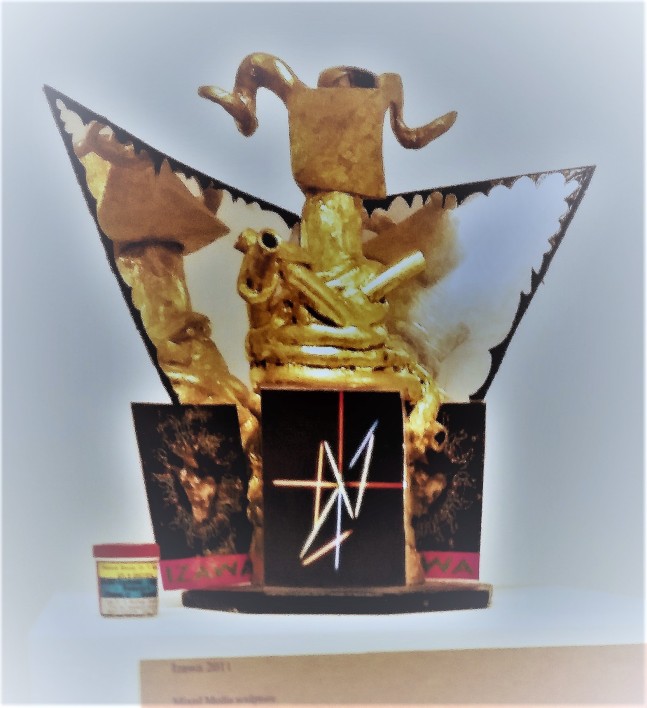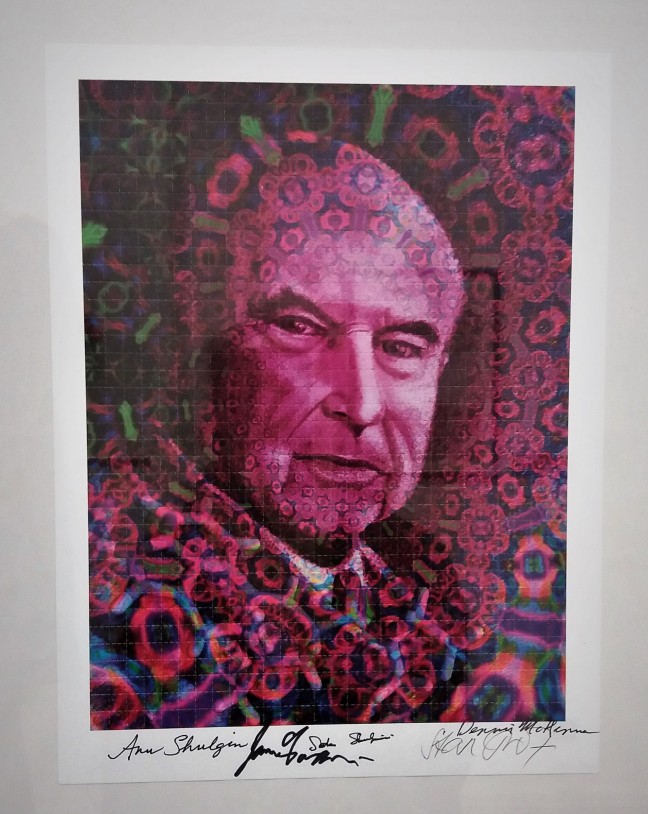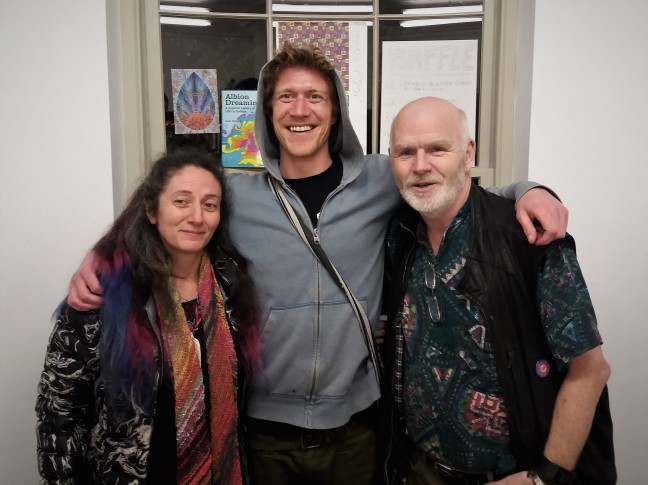The Psychedelic Museum was officially launched on Halloween of this year, and just a couple of weeks later, on Friday the 18th November the museum presented its first public show. This historic event took place at the Psychedelic Press Journal’s cover art exhibition ‘Eyes of Albion’ at The Kennington Residency, London. These combined events attracted over 200 visitors on this one evening, despite the cold weather.
I had travelled from north Devon with some choice artefacts, while two of my co-directors, Andy Roberts and Rob Dickins had brought their contributions from north Wales and southeast London respectively (Rob bringing two iconic pieces from the collection of Dave King). The Psychedelic Museum holds a ‘distributed collection‘, where the things it can call upon to exhibit remain in the ownership and care of the donor. As well as allowing the collection to grow rapidly, this methodology echoes the collective grass-roots approaches often found amongst psychedelic communities of modern times.
Arranging the objects on the wall and plinths was a fairly simple task, although Andy’s periodicals, badges, objets d’art and books had to be placed on the table to look somewhat less car boot sale (he will admit himself that he is not versed in curatorial aesthetics). The real business of the day began when the people arrived and started to wonder about the things and their stories; thus, five hours filled with dozens of enthused conversations began. These often moved on to other, related topics, and showed how the simple fact of being in the physical presence of something can change us. At this, Andy proved an eloquent advocate, talking with animated delight about his badges and keepsakes.

The container of capsules from the first LSD therapeutic study of recent years (shown above left) was marvelled at, especially by some researchers of Imperial College who had come to see the art. It sat beside a small sculpture dating from a few years later, a cause of much curiosity to the room! Izawa (2011) is a mixed media artwork. This collaborative piece was created by a group of magicians based in Sheffield. Izawa is the physical representation of the ‘spirit of the psychedelic gnosis’ and has been imbued with magical power with the aim of ‘liberating the psychedelic gnosis’. (Gnosis in this context is a synonym for altered or extraordinary state of consciousness of the type attained through the use of psychedelic drugs.)
In another part of the exhibition many of our visitors realised the enormous significance of the Hoffman blotter art on display, signed by Dennis McKenna, Ann and Sasha Shulgin, Stanislav Grof, and James Fadiman.

One aspect of a museum which I had not anticipated was the way it collects not just objects of the past, but present day people who have common interests, into the same location. And, by providing conversation pieces, they have reasons to initiate discussions. Pilgrims of their own paths, following their own threads of interest, a museum provides a loom upon which new conversations and interactions are woven.
Physical objects act as fossils of encounters; psychedelic objects infinitely more so. They mark times of meetings between minds, environments, ideas and often substances. Genesis P. Orridge’s t-shirt (design by Val Denham) provoked nostalgia and bemused looks in equal measure, from those who had, or had not, heard of Psychic TV. Either way, pioneers of electronic noise music Throbbing Gristle, and the late 20th century resurgence in body modification were soon mentioned.
By linking together moments of equivalent mind states from across geography and time, feeling our empathic resonance with fellow human beings in sheer awe at simply existing, psychedelic culture offers a glimpse into a world of familiar scenery. We can vividly imagine, to some degree, the visions encountered by those people 4,000 years ago in northwest Argentina, in a cave 3,860m above sea level, with their DMT pipe made of a puma bone; the bright colours, the intense patterns and twisting mandalas. The artefacts created and appreciated by those who have undertaken psychedelic adventures shows the undeniable commonality of our raw biological heritage, at the roots of so much of our diverse artistic and mythological interpretations of these, our most potent perceptions.
But what of the legacy of these psychedelically inclined cultures? Where can we find it recorded as an explicit narrative?

As the interest in psychedelics as medicines grows exponentially; hardly a week passes without the publication of some new research. How much of this research would have occurred without the growing interest in ayahuasca and peyote, of psilocybin mushroom species, amongst thousands of ordinary folk? …some of whom subsequently felt motivated to take up careers in science in order to research these molecules and their effects. The changes in our relationship with these substances will have great influence in how we construct our world: the intelligent use of psychedelic drugs promises (and evidence from research shows it delivers), opportunities for real world problem solving for engineers and scientists, highly effective methods for healing psychological damage, for easing our fears in the face of terminal illness, and much more.
We owe it to ourselves to tell the stories of those who have carried the torch of these drugs through the ages, through the gaol cells, through the furious anger of those righteous authority figures that declared the ‘War On (some) Drugs’.
Things – those material objects in an exhibition – provoke us to ask what, when, why, and who? Their value lies in the hands that have touched them, the eyes which were amazed in their presence. Like psychedelic substances themselves, while they can be represented (through photography or even 3D printing), there is a special value in the ‘medicine’ of the original, authentic and real. (You can, for example, watch as many trippy computer graphics as you like, but nothing compares to the authentic innerworld visions from a glass or two of ayahuasca!)
Re-imagining the world is a vital stage of any major cultural shift, and this is urgently needed now. Addressing the present through stories of the past, especially collective stories of how safe and intrinsic to the human animal is the desire to get high, can help inform our future. That these substances provide useful, healthy, enjoyable, life enhancing experiences for the vast majority of those who regularly use them is a fact; the work of the psychedelic museum, is to celebrate (though not of course without addressing difficult and contested ares of this subject) this psychedelic culture.
A museum of practices that have been criminalised and made secretive in the 20th century in most countries might provide those who enjoy such extraordinary states with validation. The traces of psychedelic culture are entwined throughout so many human activities, that only by grouping together categorically psychedelic artefacts can we show ourselves and others just how inseparable Homo sapiens and extraordinary states of consciousness have always been.
Choosing one’s state of consciousness, to be arational for a given period, gives us relief from the constant chore of concern. We return from a few hours of enhanced blissful contemplation or dancing to find our life has renewed colour; one of the most powerful predictors of life satisfaction is the knowledge that one has a mission in life. Psychedelic experiences can reveal to each of us, via an apocalyptic uncovering of the self and its relationships with others, what that mission might be.
Looking at our surroundings through psychedelicised eyes we see them anew. And this is perhaps the greatest benefit; to see, physically, the world as fresh, as open to possibility.
A table, three plinths, and a couple of hooks in the wall at an art exhibition in London which had around 200 visitors marks the first manifestation of a larger project. One day there will be a building with hundreds, thousands of things; each one telling a tale, providing a portal into other realms. Imaginative journeying, initiated by these psychedelic objects, might just take us into a future which looks a bit like the archaic past.
NW

With huge gratitude to all those who have already contributed loans of their artefacts, and donations of time and money, to this embryonic project.
Please add your support if you can to our crowdfunding appeal towards a much bigger exhibition at the psychedelic consciousness conference Breaking Convention in London 2017, and the development of this project. You can find us on Facebook too.




